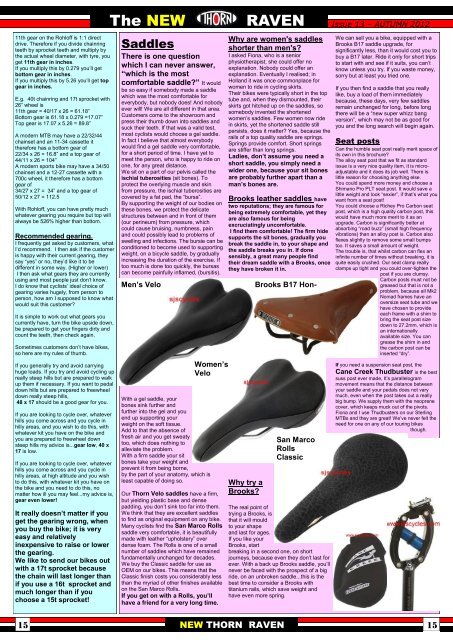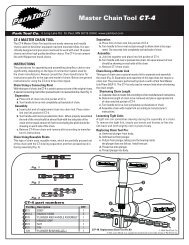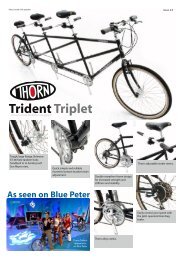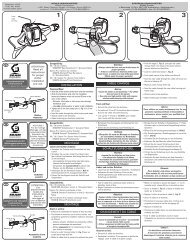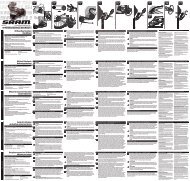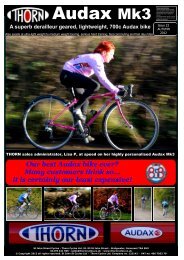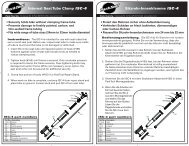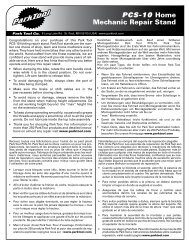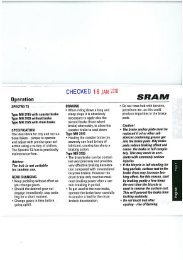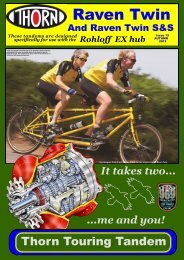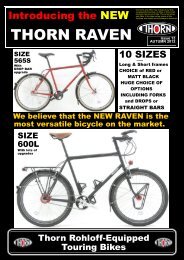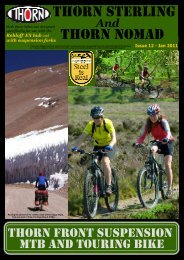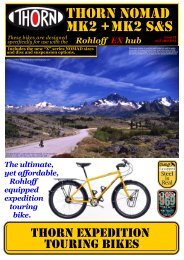You also want an ePaper? Increase the reach of your titles
YUMPU automatically turns print PDFs into web optimized ePapers that Google loves.
11th gear on the Rohloff is 1:1 direct<br />
drive. Therefore if you divide chainring<br />
teeth by sprocket teeth and multiply by<br />
the actual wheel diameter, with tyre, you<br />
get 11th gear in inches.<br />
If you multiply this by 0.279 you’ll get<br />
bottom gear in inches.<br />
If you multiply this by 5.26 you’ll get top<br />
gear in inches.<br />
E.g. 40t chainring and 17t sprocket with<br />
26” wheel is<br />
11th gear = 40/17 x 26 = 61.18”<br />
Bottom gear is 61.18 x 0.279 =17.07”<br />
Top gear is 17.07 x 5.26 = 89.8”<br />
A modern MTB may have a 22/32/44<br />
chainset and an 11-34 cassette it<br />
therefore has a bottom gear of<br />
22/34 x 26 = 16.8” and a top gear of<br />
44/11 x 26 = 104”<br />
A modern sports bike may have a 34/50<br />
chainset and a 12-27 cassette with a<br />
700c wheel, it therefore has a bottom<br />
gear of<br />
34/27 x 27 = 34” and a top gear of<br />
50/12 x 27 = 112.5<br />
With Rohloff, you can have pretty much<br />
whatever gearing you require but top will<br />
always be 526% higher than bottom.<br />
Recommended gearing.<br />
I frequently get asked by customers, what<br />
I’d recommend. I then ask if the customer<br />
is happy with their current gearing, they<br />
say “yes” or no, they’d like it to be<br />
different in some way. (Higher or lower)<br />
I then ask what gears they are currently<br />
using and most people just don’t know.<br />
I do know that cyclists’ ideal choice of<br />
gearing varies hugely, from person to<br />
person, how am I supposed to know what<br />
would suit this customer?<br />
It is simple to work out what gears you<br />
currently have, turn the bike upside down,<br />
be prepared to get your fingers dirty and<br />
count the teeth, then check again.<br />
Sometimes customers don’t have bikes,<br />
so here are my rules of thumb.<br />
If you generally try and avoid carrying<br />
huge loads. If you try and avoid cycling up<br />
really steep hills but are prepared to walk<br />
up them if necessary. If you want to pedal<br />
down hills but are prepared to freewheel<br />
down really steep hills,<br />
48 x 17 should be a good gear for you.<br />
If you are looking to cycle over, whatever<br />
hills you come across and you cycle in<br />
hilly areas, and you wish to do this, with<br />
whatever kit you have on the bike and<br />
you are prepared to freewheel down<br />
steep hills my advice is...gear low, 40 x<br />
17 is low.<br />
If you are looking to cycle over, whatever<br />
hills you come across and you cycle in<br />
hilly areas, at high altitude and you wish<br />
to do this, with whatever kit you have on<br />
the bike and you need to do this, no<br />
matter how ill you may feel...my advice is,<br />
gear even lower!<br />
It really doesn’t matter if you<br />
get the gearing wrong, when<br />
you buy the bike; it is very<br />
easy and relatively<br />
inexpensive to raise or lower<br />
the gearing.<br />
We like to send our bikes out<br />
with a 17t sprocket because<br />
the chain will last longer than<br />
if you use a 16t sprocket and<br />
much longer than if you<br />
choose a 15t sprocket!<br />
15<br />
The NEW RAVEN<br />
Saddles<br />
There is one question<br />
which I can never answer,<br />
“which is the most<br />
comfortable saddle?” It would<br />
be so easy if somebody made a saddle<br />
which was the most comfortable for<br />
everybody, but nobody does! And nobody<br />
ever will! We are all different in that area.<br />
Customers come to the showroom and<br />
press their thumb down into saddles and<br />
suck their teeth. If that was a valid test,<br />
most cyclists would choose a gel saddle.<br />
In fact I believe that almost everybody<br />
would find a gel saddle very comfortable,<br />
for a short period of time. I have yet to<br />
meet the person, who is happy to ride on<br />
one, for any great distance.<br />
We sit on a part of our pelvis called the<br />
ischial tuberosities (sit bones). To<br />
protect the overlying muscle and skin<br />
from pressure, the ischial tuberosities are<br />
covered by a fat pad, the “bursa”.<br />
By supporting the weight of our bodies on<br />
these bones, we protect the delicate<br />
structures between and in front of them<br />
(our perineum) from pressure, which<br />
could cause bruising, numbness, pain<br />
and could possibly lead to problems of<br />
swelling and infections. The bursie can be<br />
conditioned to become used to supporting<br />
weight, on a bicycle saddle, by gradually<br />
increasing the duration of the exercise. If<br />
too much is done too quickly, the bursas<br />
can become painfully inflamed, (bursitis).<br />
Men’s Velo<br />
Women’s<br />
Velo<br />
With a gel saddle, your<br />
bones sink further and<br />
further into the gel and you<br />
end up supporting your<br />
weight on the soft tissue.<br />
Add to that the absence of<br />
fresh air and you get sweaty<br />
too, which does nothing to<br />
alleviate the problem.<br />
With a firm saddle your sit<br />
bones take your weight and<br />
prevent it from being borne,<br />
by the part of your anatomy, which is<br />
least capable of doing so.<br />
Our <strong>Thorn</strong> Velo saddles have a firm,<br />
but yielding plastic base and dense<br />
padding, you don’t sink too far into them.<br />
We think that they are excellent saddles<br />
to find as original equipment on any bike.<br />
Many cyclists find the San Marco Rolls<br />
saddle very comfortable, it is beautifully<br />
made with leather “upholstery” over<br />
dense foam. The Rolls is one of a small<br />
number of saddles which have remained<br />
fundamentally unchanged for decades.<br />
We buy the Classic saddle for use as<br />
OEM on our bikes. This means that the<br />
Classic finish costs you considerably less<br />
than the myriad of other finishes available<br />
on the San Marco Rolls.<br />
If you get on with a Rolls, you’ll<br />
have a friend for a very long time.<br />
Why are women's saddles<br />
shorter than men's?<br />
I asked Fiona, who is a senior<br />
physiotherapist, she could offer no<br />
explanation. Nobody could offer an<br />
explanation. Eventually I realised; in<br />
Holland it was once commonplace for<br />
women to ride in cycling skirts.<br />
Their bikes were typically short in the top<br />
tube and, when they dismounted, their<br />
skirts got hitched up on the saddles, so<br />
somebody invented the shortened<br />
women’s saddles. Few women now ride<br />
in skirts, yet the shortened saddle still<br />
persists, does it matter? Yes, because the<br />
rails of a top quality saddle are springs.<br />
Springs provide comfort. Short springs<br />
are stiffer than long springs.<br />
Ladies, don’t assume you need a<br />
short saddle, you simply need a<br />
wider one, because your sit bones<br />
are probably further apart than a<br />
man’s bones are.<br />
Brooks leather saddles have<br />
two reputations; they are famous for<br />
being extremely comfortable, yet they<br />
are also famous for being<br />
excruciatingly uncomfortable.<br />
I find them comfortable! The firm hide<br />
supports the sit bones, gradually you<br />
break the saddle in, to your shape and<br />
the saddle breaks you in. If done<br />
sensibly, a great many people find<br />
their dream saddle with a Brooks, once<br />
they have broken it in.<br />
Why try a<br />
Brooks?<br />
The real point of<br />
trying a Brooks, is<br />
that it will mould<br />
to your shape<br />
and last for ages.<br />
If you like your<br />
Brooks, start<br />
breaking in a second one, on short<br />
journeys, because even they don’t last for<br />
ever. With a back up Brooks saddle, you’ll<br />
never be faced with the prospect of a big<br />
ride, on an unbroken saddle...this is the<br />
best time to consider a Brooks with<br />
titanium rails, which save weight and<br />
have even more spring.<br />
NEW THORN RAVEN<br />
Brooks B17 Hon-<br />
San Marco<br />
Rolls<br />
Classic<br />
Issue 13 – AUTUMN 2012<br />
We can sell you a bike, equipped with a<br />
Brooks B17 saddle upgrade, for<br />
significantly less, than it would cost you to<br />
buy a B17 later. Ride it only for short trips<br />
to start with and see if it suits, you can’t<br />
know unless you try. If you waste money,<br />
sorry but at least you tried one.<br />
If you then find a saddle that you really<br />
like, buy a load of them immediately<br />
because, these days, very few saddles<br />
remain unchanged for long, before long<br />
there will be a “new super whizz bang<br />
version”, which may not be as good for<br />
you and the long search will begin again.<br />
Seat posts<br />
Can the humble seat post really merit space of<br />
its own in this brochure?<br />
The alloy seat post that we fit as standard<br />
issue is a very nice quality item, it is microadjustable<br />
and it does its job well. There is<br />
little reason for choosing anything else.<br />
You could spend more money and choose a<br />
Shimano Pro PLT seat post. It would save a<br />
little weight and look “sexier”, if that’s what you<br />
want from a seat post!<br />
You could choose a Richey Pro Carbon seat<br />
post, which is a high quality carbon post, this<br />
would have much more merit to it as an<br />
upgrade. Carbon is significantly better at<br />
absorbing “road buzz” (small high frequency<br />
vibrations) than an alloy post is. Carbon also<br />
flexes slightly to remove some small bumps<br />
too. It saves a small amount of weight.<br />
The trouble is, that whilst carbon can flex an<br />
infinite number of times without breaking, it is<br />
quite easily crushed. Our seat clamp really<br />
clamps up tight and you could over-tighten the<br />
post if you are clumsy.<br />
Carbon posts must not be<br />
greased but that is not a<br />
problem, because all Mk2<br />
Nomad frames have an<br />
oversize seat tube and we<br />
have chosen to provide<br />
each frame with a shim to<br />
bring the seat post size<br />
down to 27.2mm, which is<br />
an internationally<br />
available size. You can<br />
grease the shim in and<br />
the carbon post can be<br />
inserted “dry”.<br />
If you need a suspension seat post, the<br />
Cane Creek Thudbuster is the best<br />
suss post ever made, It’s parallelogram<br />
movement means that the distance between<br />
your saddle and your pedals does not vary<br />
much, even when the post takes out a really<br />
big bump. We supply them with the neoprene<br />
cover, which keeps muck out of the pivots.<br />
Fiona and I use Thudbusters on our Sterling<br />
MTBs and they are great! We’ve never felt the<br />
need for one on any of our touring bikes<br />
though.<br />
15


